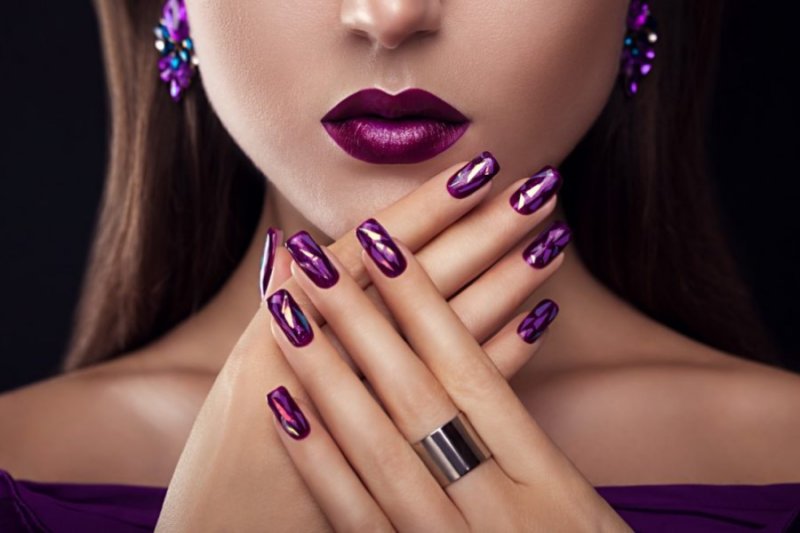Acrylic nails have been a staple in the beauty industry for nearly seven decades, cherished by countless individuals for their durability and artistic potential. Initially associated with working-class and minority communities, acrylic nails have since gained widespread acceptance as a mainstream salon option.
In the ever-evolving world of nail trends, where innovations like polygel and “builder in a bottle” systems emerge, you might find yourself wondering what sets acrylics apart and whether you should stick to this tried-and-true method. Particularly when you notice that many independent Instagram nail artists seem to be moving away from acrylics once again. However, it’s important not to overlook the multitude of advantages that acrylic nails continue to offer, which might make them the perfect choice for you.
To provide you with comprehensive insights into acrylic nails, we reached out to nail technicians, a cosmetic doctor, and an avid acrylics enthusiast. We aim to address all your burning questions about acrylic nails, covering everything from safe removal techniques to practical tips for daily activities, such as how to manage with acrylics when it comes to personal hygiene.Here is all the information you want regarding acrylic nails.
What Are Acrylic Nails & What Are They Made Of?
Acrylic nails, often simply called “acrylics,” are a popular artificial nail style frequently offered at nail salons. Thi Vu, who serves as the Director at Bondi Nails in Sydney, explains that acrylic nails are created using a mixture of acrylic powder and a liquid monomer. This mixture is applied over your natural nails to enhance their strength, or it can be used with extension tips or sculpting forms to increase nail length.
The history of acrylic nails dates back to the 1970s, although the concept itself was first conceived by a dentist named Frederick Slack nearly two decades earlier. Slack had used dental acrylics to repair his own broken nail, paving the way for the development of this nail enhancement technique.
Cosmetic Physician and founder of Skin Club, Dr. Vihang Sharma, sheds light on the composition of acrylic nails. They are primarily composed of acrylic plastic, derived from a chemical known as methacrylate. However, it’s worth noting that acrylic nails are not considered eco-friendly due to their core ingredients taking approximately 200 years to decompose.
Dr. Sharma raises environmental concerns, explaining that when acrylic plastic is disposed of in landfills, it can persist there for many years, releasing toxic gasses and chemicals into the environment, thereby impacting both the air and water quality. Notably, this environmental issue isn’t unique to acrylic nails, as gel nails also contribute to the problem of microplastics.
Who Should Get Acrylic Nails?

Jade Pham, a skilled nail artist and the founder of CJ Artistry in Granville, Western Sydney, shares valuable insights about the pros and cons of acrylic nails. According to her, there are definite advantages and considerations to keep in mind when opting for acrylics.”The benefits are that you instantly achieve length, structure, and strength for your nails,” she says. “However, the drawbacks include the requirement for routine maintenance and the artificial nature of acrylics.”
Pham points out that, in general, acrylic nails are suitable for most individuals. Nonetheless, it’s crucial to be aware that some people may experience adverse reactions to acrylics, which can manifest as pain, swelling, itching, redness, or even blisters. To ascertain whether someone might be sensitive to the acrylic system, a product test can be conducted on a nail. Pham advises, “If the client experiences any symptoms, they might have an allergic reaction to acrylics. However, if the discomfort subsides after one to two weeks, it could have been merely an irritant reaction.”
Before committing to the acrylic nail technique, it’s a good idea to ask your nail technician for a patch test, just as you would when introducing any new cosmetic product into your regimen. Your convenience and security should always come first.
What Is The Process Of Applying Acrylic Nails?
“To ensure the longevity of your acrylic nails, proper nail preparation is absolutely crucial,” advises Vu when discussing the process with Refinery29 Australia. The initial steps involve your nail technician gently pushing back your cuticles to eliminate any loose skin or hangnails. Following this, there’s a conversation about whether you want to extend the length of your natural nails or not.
If you want longer nails, Vu says that they will be added using manicure tips or nail forms and shaped to your preferred length and style. “To ensure a perfect fit, we painstakingly measure, cut, and file the tips.”
Nevertheless, it’s worth noting that acrylics can also be applied directly onto your natural nails without extensions, a technique known as acrylic overlay. Vu mentions, “This is particularly beneficial for nail biters who are looking to strengthen and grow out their natural nails.”
Next in the process, a whirring grit tool, called a sanding band, is employed to gently roughen the nail bed’s surface, ensuring proper adhesion of the acrylic. The nail beds are then meticulously cleaned with alcohol to eliminate all traces of dust and oils. Following this, a primer is applied before the acrylic application, marking the beginning of the creative phase.
Vu explains further, “We dip a specialized acrylic brush into a liquid monomer, then into acrylic powder. The combination forms a workable blob called a bead.” This bead is carefully placed on the nails and sculpted to create a seamless and thin artificial nail.
After the clear acrylic has been applied to the nail, a brief waiting period ensues as the bead sets. Once it’s completely dry, it undergoes manual filing to achieve your desired length and shape. An electric file is then used to refine and smooth the nail’s surface.
The final and most exciting step, according to Vu, is where creativity comes into play. She screams, “The final step involves adding color, a top coat, nail art, diamonds, or whatever your heart desires.” “And there you have it!” Your beautifully designed acrylic nails are ready to shine.
How Much Do Acrylics Cost?
The cost of getting a full set of acrylic nails in Australia can vary depending on the place you choose, but on average, you can expect to pay around $45 to $55. At CJ Artistry, Jade Pham maintains consistent pricing for builders in a bottle, gel, and acrylic nails due to the high-quality products they use across the board. However, it’s worth noting that many independent nail technicians and artists tend to charge more compared to nail salons located in shopping centers, primarily due to the cost of materials and their expertise.
As Pham adds, “Gels on the market are typically more expensive than acrylics.” Whether you live in a city, town, or suburb, keep in mind that nail care costs might vary greatly depending on where you are, so it’s always a good idea to check with your local salons for exact pricing.
Why Do People Go For Acrylics?
Maria, a 25-year-old, shares with Refinery29 Australia that when she’s in the mood for acrylic nails, she opts for new sets every two to three weeks. She expresses her passion for having her nails look cute and fabulous, and in her opinion, acrylics perform exceptionally well on short nails. According to her, they are the go-to choice when it comes to maintaining that chic nail appearance. She does recall trying soft gel extensions on occasion but found that they didn’t last long, as they lacked the grip she needed.
“I’m all about the long round shape, not too almond,” Maria explains regarding her preferred nail style. However, she does acknowledge that her nails tend to become thinner while wearing acrylics, which ironically makes it more challenging to grow them out naturally – a bit of a classic Catch-22 situation.
Acrylic Nails Vary From SNS, Gel, And Polish
Acrylic nails are distinctive for their use of a liquid and powder combination, and they set naturally without the need for an LED light. You can still apply gel polish or Shellac on top of acrylics once the bead has set on the nail bed.
In contrast, SNS involves a different process. It starts with painting the nail with an adhesive base polish before dipping your finger into a jar, tapping off excess in layers. It’s somewhat akin to using a glue stick on cardboard paper and then sprinkling glitter on it. When your nails have grown out with SNS, they require complete removal. “SNS and acrylic are somewhat similar in terms of formulation, but each type has its unique characteristics,” notes Dr. Sharma.
Then there are gel extensions, often referred to as hard gel. This mixture comes pre-mixed, resembling a goop in a pot, and it’s cured with an LED light to dry and adhere. This differs from gel polish, or soft gel, which is a more robust form of nail polish set with LED lights between layers. Dr. Sharma points out that these lacquer types won’t add length to the nail but can offer some strengthening, depending on the formula. On the other side, Heinz is a trademarked brand of baked beans, much as Shellac is for gel polish.
The traditional manicure is the last option, which you may acquire at a salon or do at home. You just need to apply a couple coats of ordinary nail paint to be ready to go. How does this differ from acrylics? “Regular nail polish is essentially a lacquer composed of ingredients like nitrocellulose, typically mixed with ethyl acetate or butyl acetate,” clarifies Dr. Sharma.
And as for the enduring charm of acrylic nails, well, as Dr. Sharma puts it, “I think SZA said it best when she said, ‘picking up a penny with a press-on is easier than holding you down,’ because you can do anything after you’ve got acrylic nails on for a while.
Have Acrylics Gone Out Of Style?
If you follow independent nail artists on Instagram, you may have noticed that a lot of them these days appear to be eschewing acrylics in favor of working solely with gel products. However, according to Pham, acrylics are still widely used today, and ultimately, it comes down to choice.
Due to their user-friendliness and adaptability, gel nails have been gaining popularity over the last year or two, and I anticipate that this year they will become the nail system of choice for many individuals. She observes. Pham explains that gel nails require fewer steps, less technique, and less training from a technician’s perspective.”Compared to acrylics, they are also easier to remove and kinder to the nails. However, gel nails have their own set of benefits and drawbacks, just like any other product. It’s critical that consumers comprehend that no product is intrinsically “healthier” than others. People can still experience reactions with gel products as well.”
How Long Acrylic Nails Last?
With proper care and attention, acrylic nails can maintain their pristine appearance for several months before the initial set begins to display signs of chipping or wear. However, the key to achieving this extended lifespan and preventing unsightly nails lies in regularly filling in over the nail regrowth.
Vu notes that “Acrylics are enhancements that need regular filling when your natural nails grow out.” “With this method, there is no longer a need to take the complete set apart to give the room a new appearance. It’s a way to refresh and renew your nails without causing unnecessary damage to your natural ones.”
If the original acrylics start to lift off the nail bed, they are gently filed down before applying an additional layer over the newly exposed natural nail. This maintenance procedure should typically be done every two to three weeks, depending on the rate of growth of your natural nails.
We advise daily use of cuticle oil, refraining from using your nails as tools, and keeping a regular schedule for nail infill treatments in order to maximize the life of your acrylic nails. Vu advises. Taking these steps will help ensure your acrylic nails stay looking their best for as long as possible.
Can Acrylics Damage Your Nails?
According to Pham, when it comes to nail products, acrylics have been the reigning champion in terms of longevity compared to newcomers like SNS and gel manicures. She explains, “New nail systems constantly hit the market, but none have surpassed acrylics, thanks to the product’s exceptional strength and durability.”
If you choose not to maintain your acrylic nails with regular fills, they may start to look a bit less attractive, but the risks typically end there. Pham dispels the notion that acrylic nails are inherently “bad” for you, stating, “Any type of nail enhancement requires maintenance every two to three weeks. This is crucial to ensure the structural integrity of your growing nails. I’ve been wearing acrylics for 17 years and haven’t experienced any adverse reactions or issues.”
Pham emphasizes that most damage to nail plates, regardless of the nail system used, usually results from external factors, such as trauma or overall nail health. These factors are often context-specific and not solely dependent on the choice of nail product. For instance, issues may arise if your nail technician lacks proper training or if you have a habit of picking or biting your nails.
Dr. Sharma chimes in, pointing out that individuals who wear acrylic nails may occasionally face the “dreaded snapped nail” scenario where the nail lifts from the nail bed, potentially leading to infections. However, this too can be attributed to various factors. He cautions that applying acrylics may require significant filing for adhesion, and the removal process can weaken nails, possibly causing damage at both the start and end of the acrylic nail set’s lifespan.
While Dr. Sharma acknowledges that there aren’t any significant long-term safety concerns directly related to acrylic nails, he does express some concern about other materials used in the process, such as adhesives that can potentially trigger skin issues like contact dermatitis, as Pham also acknowledges. As always, selecting a trustworthy nail technician can help minimize any associated risks.
How Do You Remove Acrylic Nails?
While it might be tempting to take matters into your own hands when it’s time to remove acrylic nails, Vu strongly advises against it, as attempting to remove them yourself can lead to more harm than good.
“Never attempt to rip or hack off acrylic nails,” Vu emphasizes. “This can result in serious damage to your nail bed.”
The proper method for removing acrylic nails involves soaking. A skilled nail technician will use an electric file to file away the bulk of the acrylic, leaving behind a thin layer. Afterward, the nail is wrapped in a cotton wool ball soaked in acetone and enclosed with aluminum foil.
The remaining layers may be carefully scraped off without damaging the nail bed when the acrylic softens, according to Vu. “Following this, we delicately buff the nail bed to leave it smooth and shiny.”
Once the old acrylic nails are successfully removed, you have options for what comes next. You might choose to get them redone for a brand-new set, get a straightforward manicure, or just let your natural nails grow in between visits. You have an option, and it’s a terrific method to keep your nails healthy and looking their best.
What Tasks Are Easier And Harder With Acrylics On?
Maria offers a candid and amusing perspective on the world of acrylic nails. She humorously quotes SZA, saying, “‘Picking up a penny with a press-on is easier than holding you down.’ Because when you’ve sported acrylic nails for a while, you feel like you can conquer anything.” According to her, there are plenty of perks to having acrylics: they look cuter, they come in handy for scratching various itches, and people appreciate the tactile sensation when you touch them – it’s a nice feeling. Plus, they make tasks like putting on necklaces easier since you have more dexterity than with your natural nails.
Maria does admit that typing can be a bit of a challenge with longer acrylic nails, especially if your job involves constant keyboard use on a laptop or phone. Her advice is to practice before returning to work or to opt for shorter nail lengths if typing is a critical part of your work.
She humorously recounts her own mishap with acrylic nails when she attempted to make her bed with an exceptionally long set on. Her mattress landed on her hand, and her brain didn’t quite recognize the acrylic nails as extensions. This resulted in a nail being ripped off, a situation she shares is relatively common among acrylic nail wearers. It sent her to the emergency room, and she had to wait for her natural nail to regrow.
Addressing concerns about debris and dirt collecting under acrylic nails, Maria reassures that basic hygiene practices can keep them clean. She points out that while some people use one acrylic nail to dig out debris from under another, it’s important to be cautious about causing microtears or damage to your natural nails. Her advice? Simply wash your hands regularly.
Maria also touches on intimate matters, noting that acrylic nails might pose certain challenges for individuals in same-sex relationships or during solo activities like masturbation. However, she playfully suggests that a vibrator can easily solve those issues.
Finally, Maria dispels the misconception that wiping in the bathroom can be difficult with acrylic nails, mentioning that her nails have never been long enough to pose an obstacle. She adds, “Most of the time, I never even think about my nails when I’m doing that.”
Final Words
Acrylic nails have a rich history in the beauty industry, offering durability and creative possibilities. They are composed of acrylic plastic, though their environmental impact is a concern. Acrylic nails are suitable for most individuals, but sensitivity should be monitored. Proper preparation and maintenance are key to their longevity, and costs may vary.
Acrylics provide length and strength, making them a popular choice for many, but other options like gel nails are gaining popularity due to their user-friendly nature. Despite misconceptions, acrylic nails don’t necessarily damage natural nails; it depends on various factors and proper care.
Removing acrylic nails should be done by a professional to avoid harm to the nail bed. Acrylics can make some tasks easier, like scratching itches and putting on necklaces, but typing and certain activities may require adjustments.
Ultimately, whether you choose acrylic nails or another nail enhancement method, it’s essential to prioritize your comfort, safety, and overall nail health.













